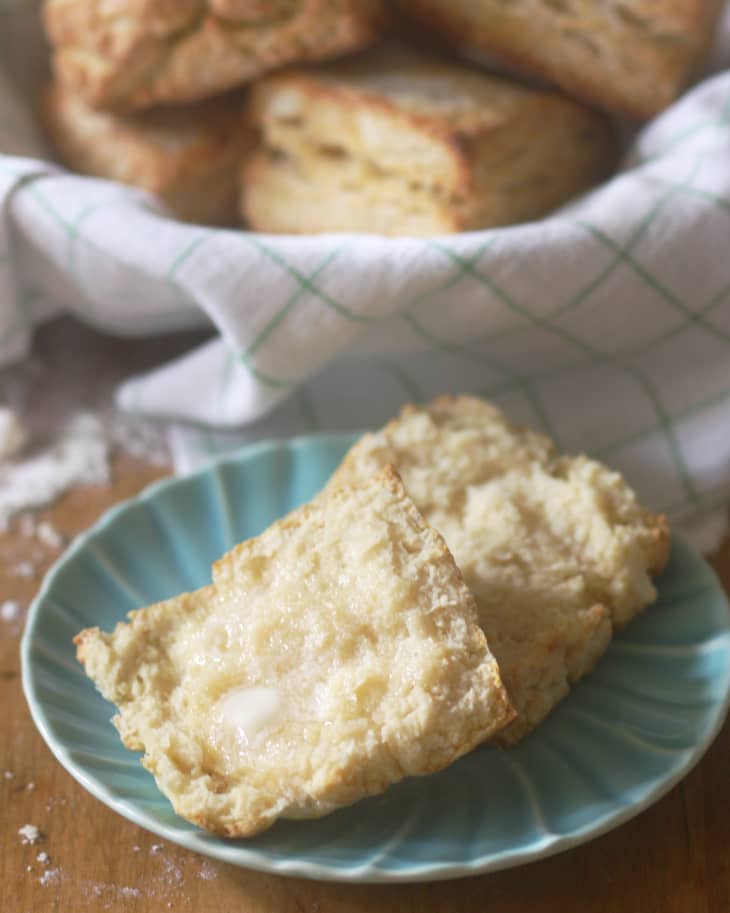5 Mistakes to Avoid When Making Biscuits
Like anything purported as easy, biscuits are also notoriously easy to mess up. Simplicity, as it turns out, leaves plenty of room for error. Luckily I have quite a few biscuit makers to call on to discuss the common mistakes people make when preparing biscuits, and even better, the tips you need to know to avoid them all together. So before you get ready to bake up you next batch, here are five mistakes you’ll want to steer clear of.
1. Starting with room-temperature ingredients.
Biscuits are a type of quick bread (because they require no rising time before baking) with their moon in pastry. Like pastry dough, biscuits get their tender crumb and layers from the suspension of fat in flour. The fat, be it butter, lard, or vegetable shortening, needs to be dispersed throughout the dough while still in its solid state, so warm or room-temperature liquid or fat will disrupt this process.
I asked my mother, who is from North Carolina, how my grandmother made the biscuits she was so famous for. It’s worth noting that my mom isn’t much of a cook. In fact, I don’t think that woman has made a biscuit my entire life, but a memory came spilling out of her in response to the question and with it, a very good tip.
Follow this tip: My grandmother put a metal mixing bowl of flour in the fridge the night before she was going to make biscuits so she’d wake up to a chilled bowl and chilled flour to start with. The same goes for the buttermilk and butter. Keep things cold until it comes time to do the mixing and don’t hesitate to stick the bowl in the fridge or freezer for a cool-off midway through if you feel the fat melting in your hands. And while we’re on the subject of fat melting in your hands, if you’re feeling hardcore, go ahead and plunge your hands in some ice water before you start mixing.
2. Using a stand mixer or hand mixer.
A gentle touch is key when making biscuits, as you want all the ingredients to just come together — not blend into batter. Using any kind of mixer, stand or otherwise, means you run the risk of overworking and overheating the dough, resulting in a biscuit that shares more in common with a hockey puck than a tender baked good.
Follow this tip: Biscuit-making is tactile. Use you hands, a pair of forks, or a pastry cutter to work the fat into the dough and then stop the moment things are mixed. Be gentle folding in any mix-ins. While stand mixers are out, the food processor, however, is an exception. Certain biscuit recipes are designed to be entirely made in a food processor, but the same general principles of not overworking the dough remain. If you’re using a food processor for a recipe that doesn’t specifically call for you to do so, mix the fat into the dough in the processor and then transfer the mixture to a bowl, add the liquid, and continue mixing with your hands. And don’t forget to chill the blade if you go that route.
3. Re-rolling the dough too many times.
Biscuit-making isn’t a perfect science, but there is a point of diminishing return when comes to how many times you can re-roll the dough to eek out that last biscuit. Twice is the limit; any biscuit made from dough rolled out after that is back to hockey-puck status.
Follow this tip: If you’re following a recipe, don’t forget to pay attention to the number of biscuits it makes so you have a fair idea of how much to roll it out. A solid recipe will tell you how thick the dough needs to be, which makes for more precision and less guessing. Otherwise, be prepared to just roll with it (ha!) and get the most you can out of two times through. Take notes (mental or otherwise) so the next time you make that recipe you have a game plan about how thickly to roll out the dough and how many biscuits to cut.
4. Not preheating the oven.
Want sky-high biscuits that rise like nobody’s business? Well you won’t get that with a tepid, partially heated oven. As with most baking, the preheat is essential because it ensures your dough immediately hits the heat and kickstarts the coveted rise that results in tall, flaky biscuits.
Follow this tip: Friends, preheat your oven. And if you can spare the extra five minutes or so, let it heat up a few more minutes after it beeps. And if you don’t have an oven thermometer, it’s worth investing for better baking all around.
5. Taking biscuit-making way too seriously.
The best biscuits I’ve ever eaten (sorry, Grandma!) are from Willa Jean in New Orleans. They are everything you’d want a biscuit to be: tall and tender, moist, buttery, with a golden crusty top and bottom and pillowy center. I mean, good. I asked the chef Kelly Fields what mistakes people often make when making biscuits. Her reply was quick and definitive: “They take it too seriously! If you think too much about it, that’s when you start to make mistakes.”
Follow this tip: In many homes with Southern roots, biscuits are an everyday kind of quick bread. For some of us, they’re something we make only when the fancy strikes. Regardless of why you’re whipping up a batch, biscuit-making should be enjoyable. After all, half the time your hands are deep in butter and flour, and the other half, your house is being perfumed with the buttery scent of baking. Know the principles, give your recipe a good read-through before getting started, and if you only do one more thing, please keep everything cold!
